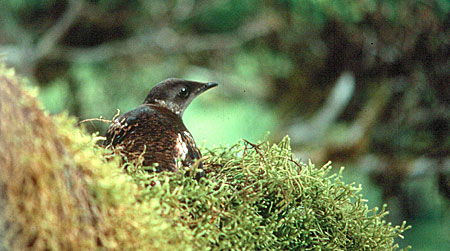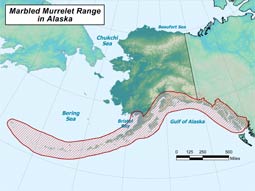Marbled Murrelet
(Brachyramphus marmoratus)
Printer Friendly
Did You Know?
Alaska harbors over 85% of the world’s population.
General Description
Marbled Murrelets are in the same family as auklets, puffins and murres. All members of the Alcid family swim under water, propelling themselves with their wings, much like their Penguin counterparts in the southern hemisphere. These birds have slender black bills, long, narrow wings and short tails. Murrelets, like many birds, have two different sets of plumage. During the breeding season, adult murrelets are marbled gray-brown, providing excellent camouflage at their nests. In winter, feathers are black above, white and gray below with white shoulder patches and a white throat. Juvenile birds resemble adults in winter plumage. Marbled Murrelets have a distinctive high pitched “keer, keer” call, making them easy to identify.
Life History
Marbled Murrelets have been called “the Enigma of the Pacific” as they are one of the last birds in North America to have their nest described. In the United States, the first documented nest was discovered in 1974 high up in a Douglas fir tree in California’s Big Basin Redwoods State Park. Advances in technology have allowed researchers to attach tiny radio-transmitters to adults captured at sea, and follow them back to their nests. To date, several hundred Marbled Murrelet nests have been located and described. The species nests primarily in mature coniferous trees. A small number of murrelet nests have been found in Alaska including, some on the ground on moss-covered ledges in areas with few trees.
Beginning in early April, murrelets make their way from wintering areas to coastal inlets and bays for breeding. Pairs typically initiate nesting in May, although some birds may initiate nests as late as July. Murrelets do not build a nest; instead they usually nest on moss-covered limbs high in the forest canopy. A single egg is laid in a shallow depression in the moss. The male and female share in incubating the egg for 28-30 days. They exchange incubation duties under the cover of darkness presumably to avoid leading predators, such as corvids and raptors, back to the nest. Soon after hatching, the chick is left alone on the nest, growing rapidly on a diet of small fish over the next 30 days. The parents take turns flying from sea back to the nest 3-5 times a day, returning with a single fish carried in their bill. The young murrelet must reach the ocean on its first flight. Landing anywhere short of the ocean means likely death for the chick, as Marbled Murrelets are unable to take off once grounded in the thick understory of the forest. Flying on its own, the fledgling must navigate over the forest to the sea. Young murrelets, with their distinctive black and white plumage, are seen on Alaska’s waters beginning in July with numbers increasing through the end of the month. Both juveniles and adults tend to move away from breeding/feeding grounds once the summer is over. Nests are not necessarily re-used the following year, but a pair may return in subsequent years to the same stand of trees. Murrelets are relatively long-lived birds with an average lifespan of 10 to 15 years.
In Alaska, murrelets eat small schooling fish, such as Capelin, Pacific Herring and Pacific Sand Lance, as well as shrimp-like crustaceans. Murrelets are excellent swimmers and use their strong wings to literally “fly” underwater to forage at depths up to 100 feet. The distribution of prey largely influences the distribution of murrelets throughout the year.
Range and Habitat
The species occurs from northern California, along the coasts of Oregon, Washington, British Columbia and Alaska. In Alaska, the largest populations are in Southeast. The species is less abundant in Prince William Sound, Cook Inlet, Kodiak, the Alaska Peninsula and the Aleutian Islands. Murrelets winter throughout their range and also occur in small numbers in southern California.
The Marbled Murrelet is marvelously adapted to life amidst the emerald-green islands and cold, marine waters along the northwest coast of North America. Marbled Murrelets depend on both marine and forest habitat. Murrelets are general found in near-shore waters (within 3 miles from the coast) with nesting areas nearby. Some birds may venture miles inland to suitable nesting habitat. Unlike typical seabirds that nest in dense colonies on remote islands, the Marbled Murrelet is a solitary, secretive nester, preferring the mossy boughs of mature coniferous trees in the coastal rainforest. While some murrelets remain at breeding areas year-round, others migrate further south. It remains a mystery where the majority of Alaska’s murrelets spend the winter.
Status, Trends, and Threats
In 1992, the U.S. Fish and Wildlife Service (USFWS) listed the Marbled Murrelet as Threatened in Oregon, Washington and Endangered in California under the Federal Endangered Species Act. They are a red list species in Canada, which is similar to the U.S. listing as a threatened species. Populations are declining at an annual rate of 4-7% across the southern portion of their range. It is believed that Marbled Murrelets will likely become extinct in California within the next 40 years.
Marbled Murrelets are relatively abundant in Alaska compared with populations in other parts of their range. Their numbers in Alaska, however, may be a misleading indicator of the bird’s security. In 2007, the US Geological Survey published a status report on Marbled Murrelets in Alaska and British Columbia. Extrapolating from declines in multiple study areas in Alaska, the report concludes that populations in Alaska have undergone a 71% decline since the early 1990’s, dropping from nearly a million birds to about 271,000 today. Scientists do not know the exact cause of the decline, but suspect multiple factors are involved. Marbled Murrelets face a number of threats, which contribute to observed declines in populations across much of their range.
The loss of old-growth nesting habitat due to logging, primarily in the southern half of its range, is thought to be the most significant threat to the species. Oil spills can severely impact murrelet populations through oiling of the birds’ feathers. And there is concern in Alaska and Canada regarding the numbers of murrelets that are entangled in commercial fishing nets. Changes in the marine environment driven by global climate change are likely affecting the abundance and distribution of prey species that these birds depend on.
Fast Facts
-
Size
Length 24-25 cm (9-10 in.), Weight 7-8 ounces -
Distribution/Range
Southeast Alaska, Prince William Sound, Cook Inlet, Kodiak, Alaska Peninsula and the Aleutian Islands. Species occurs from Northern California along the coasts of Oregon, Washington, British Columbia and Alaska. -
Diet/Feeding Type
Schooling Fish (eg. Herring, Capelin, Pacific Sand Lance) and Invertebrates -
Reproduction
Asynchronous nesting (time of egg laying varies), single egg 28-30 day incubation, both male and female share in incubation and feeding of young. Fledging occurs after approximate 30 days. -
Predators
Avian predators including: Common Raven, Northwestern Crow, Steller�s Jay, Northern Goshawk, Peregrine Falcon and Bald Eagle.
Did You Know?
- Alaska harbors over 85% of the world’s population.
- Marbled Murrelets are the only known alcid species to nest in old-growth trees.
Research
As a federally listed species, Marbled Murrelets are under the jurisdiction of the U.S. Fish & Wildlife Service. The Alaska Department of Fish and Game, Division of Wildlife Conservation is currently partnering with federal agencies, universities and conservation organizations to strengthen monitoring efforts and conduct ongoing research, primarily in Southeast Alaska. Several research projects in Alaska related to nesting habits, foraging ecology and distribution have been completed since 2004. At-sea surveys conducted by USFWS in 1993 will be repeated in the 2010 field season through a partnership between ADF&G and Alaska Audubon, providing important population trend information of Marbled Murrelets in Glacier Bay.
- Abundance, Population Trend & Distribution of Marbled Murrelets and Kittlitz’s Murrelets in Glacier Bay National Park, 2010 (PDF 7,118 kB)
- Methodological Considerations for At-sea Monitoring of Brachyramphus Murrelets in Glacier Bay 2008 (PDF 1,370 kB)
- At-sea Habitat Use and patterns in spatial Distribution of Marbled Murrelets in Port Snettisham, Southeast Alaska (PDF 815 kB)
- 2008 Murrelet Watch Final Report (PDF 123 kB)
- 2007 Murret Watch Progress Report (PDF 1,012 kB)
- Information provided by State of Alaska to the U.S. Fish and Wildlife Service to aid in the preparation of the status review for this species (PDF 131 kB)
- Missing Murrelet Mystery: Seabird Research in Glacier Bay
- Students help monitor Marbled Murrelets in Southeast Alaska
ADF&G Partner Research
More Resources
General Information
- Marbled Murrelet — Wildlife Notebook Series (PDF 43 kB)
- Marbled Murrelets in Southeast Alaska (PDF 906 kB)


